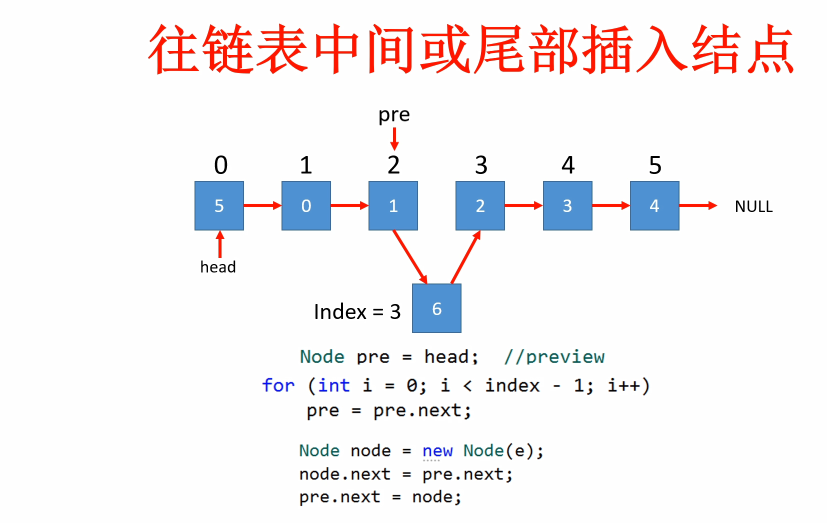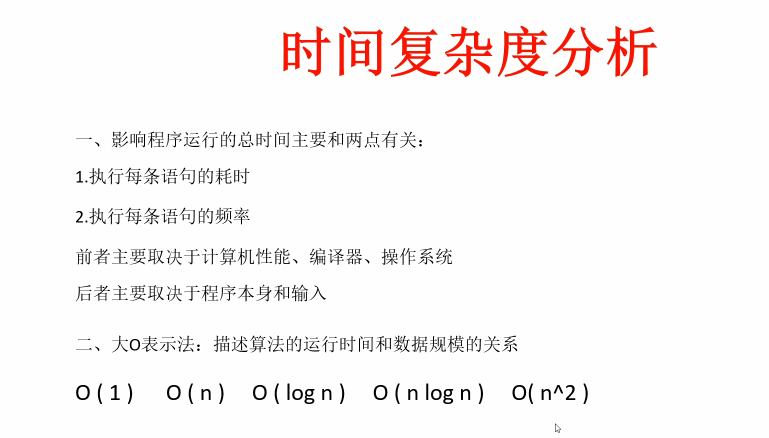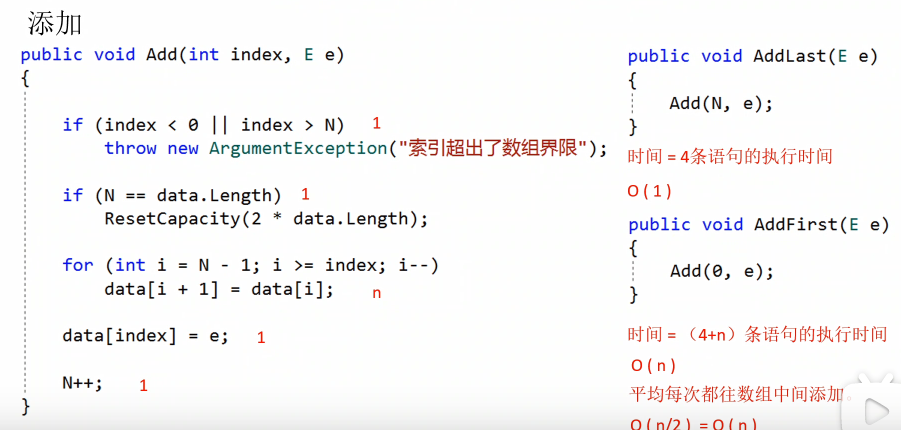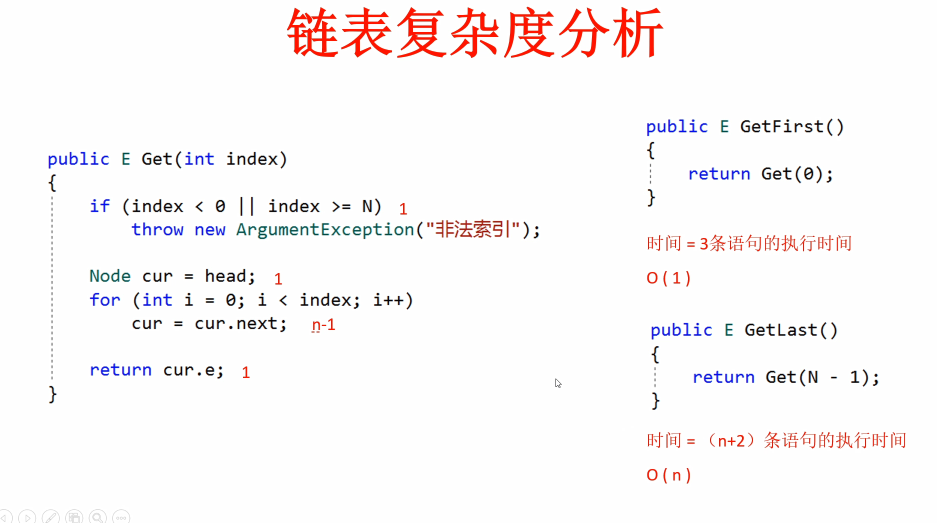引用B站离忧夏天的视频
1.从动态数组的原理中我们知道,就算是使用动态数组,我们也还是未能完全利用全部的空间,所以可以使用链表实现。

从上图我们可以看出,数组在查询数据方面要比链表更快速,可以通过索引快速查询,但是链表不行,比如我要找3节点,就必须知道2节点,根据2节点找到下一节点3,同理一次向前推,一切的开始就必须要知道节点的最开始点,也就是头节点0才行。
我们可以自己创建一个链表类,看一下具体实现原理:
先开始实现一个简单的链表类,链表中存在很多节点,把这些节点抽象出类,节点类同时需要记录当前节点的信息以及下一节点的信息。链表类还要有头部节点的信息,以及知道当前总共的节点数量。
在c#中LinkedList类是封装好的一个链表类,下面自定义的一个链表类和封装好的类名称一样,不要混了。
public class LinkedList<T> { //当前链表类记录这个链表的头部类 private Node head; //链表的节点数量 private int N; public LinkedList() { N = 0; //因为一开始链表没有元素,所以头部节点指向空。 head = null; } /// <summary> /// 链表节点数量 /// </summary> public int Count { get { return N; } } /// <summary> /// 链表是否为空 /// </summary> public bool IsEmpty { get { return N == 0; } } /// <summary> /// 节点类 不让外部知道此类,设为私有 /// </summary> private class Node { //当前节点 public T e; //当前节点的下一节点 public Node next; public Node(T e, Node next) { this.e = e; this.next = next; } public Node(T e) { this.e = e; } } }
下面实现往链表的头部插入元素:

看上图是链表往头部添加节点的实现过程,链表和数组不同,数组添加元素是很麻烦的,需要对原有数据进行重新移位,而链表是只要其中的任意节点和另一节点有关联就可以,比如我要往头节点插入一个新节点,那么原先的头结点0就不是头节点,而5变成新的头结点,所以此时只需要将5节点的下一节点指向0,链表类中记录的头结点改成5即可,比数组快很多。
下面是往中间或尾部插入节点:

如图:将节点6插入到index=3的地方,也就是节点2与节点3之间的位置,需要知道前一节点2的信息,要知道2节点信息,对于链表来说就必须从头部节点一步一步的找,找到2节点之后,先将2节点存储的下一节点的信息给6节点,然后将6节点的信息给2,此时新的链表形成了,比数组便捷多了,数组还要对原有数据进行重新移位排序。当然查询数据的话数组更快,根据索引直接就能查到。
代码实现:
public class LinkedList<T> { //当前链表类记录这个链表的头部类 private Node head; //链表的节点数量 private int N; public LinkedList() { N = 0; //因为一开始链表没有元素,所以头部节点指向空。 head = null; } /// <summary> /// 链表节点数量 /// </summary> public int Count { get { return N; } } /// <summary> /// 链表是否为空 /// </summary> public bool IsEmpty { get { return N == 0; } } public void Add(int index, T e) { if (index < 0 || index > N) { throw new Exception("非法索引"); } if (index == 0) { //新的头部节点 //1:添加新节点 Node node = new Node(e); //2:将新添加的头结点的箭头指向原先头结点 node.next = head; //3:现在的头结点信息赋给类的头结点字段,记录下来。 head = node; //其实上面三步可以结合到一步中, head = new Node(e, head); } else { //添加非头部节点 //1.需要找到插入位置的上一个节点,对于链表来说就要从头部节点开始一步一步的查找了 Node pre = head; //一步一步遍历找到前一个节点信息 for (int i = 0; i < index - 1; i++) { pre = pre.next; } //1:将前一节点的下一节点信息赋值给当前节点对象的下一节点字段,目的是为了让当前节点能够链接到下一节点 Node node = new Node(e); node.next = pre.next; //2:前一节点链接到新插入的节点 此时链表已经重新完成 pre.next = node; //上面代码也可以合成一句 pre.next = new Node(e, pre.next); } //链表的元素加一 N++; } public void AddFirst(T e) { Add(0,e); } public void AddLast(T e) { Add(N, e); } /// <summary> /// 节点类 不让外部知道此类,设为私有 /// </summary> private class Node { //当前节点 public T e; //当前节点的下一节点 public Node next; public Node(T e, Node next) { this.e = e; this.next = next; } public Node(T e) { this.e = e; } } }
然后我们需要实现查询节点信息功能,链表中查询某个节点信息需要从头结点一步一步往后查找,

public class LinkedList<T> { //当前链表类记录这个链表的头部类 private Node head; //链表的节点数量 private int N; public LinkedList() { N = 0; //因为一开始链表没有元素,所以头部节点指向空。 head = null; } /// <summary> /// 链表节点数量 /// </summary> public int Count { get { return N; } } /// <summary> /// 链表是否为空 /// </summary> public bool IsEmpty { get { return N == 0; } } public void Add(int index, T e) { if (index < 0 || index > N) { throw new Exception("非法索引"); } if (index == 0) { //新的头部节点 //1:添加新节点 //Node node = new Node(e); ////2:将新添加的头结点的箭头指向原先头结点 //node.next = head; ////3:现在的头结点信息赋给类的头结点字段,记录下来。 //head = node; //其实上面三步可以结合到一步中, head = new Node(e, head); } else { //添加非头部节点 //1.需要找到插入位置的上一个节点,对于链表来说就要从头部节点开始一步一步的查找了 Node pre = head; //一步一步遍历找到前一个节点信息 for (int i = 0; i < index - 1; i++) { pre = pre.next; } //1:将前一节点的下一节点信息赋值给当前节点对象的下一节点字段,目的是为了让当前节点能够链接到下一节点 Node node = new Node(e); node.next = pre.next; //2:前一节点链接到新插入的节点 此时链表已经重新完成 pre.next = node; //上面代码也可以合成一句 // pre.next = new Node(e, pre.next); } //链表的元素加一 N++; } public void AddFirst(T e) { Add(0, e); } public void AddLast(T e) { Add(N, e); } /// <summary> /// 节点类 不让外部知道此类,设为私有 /// </summary> private class Node { //当前节点 public T e; //当前节点的下一节点 public Node next; public Node(T e, Node next) { this.e = e; this.next = next; } public Node(T e) { this.e = e; } } public T Get(int index) { if (index < 0 || index >= N) { throw new Exception("非法索引"); } Node currentNode = head;//从头结点开始查找 for (int i = 0; i < index; i++) { currentNode = currentNode.next; } return currentNode.e; } public T GetFirst(int index) { return Get(0); } public T GetLast(int index) { return Get(N - 1); } /// <summary> /// 修改 /// </summary> /// <param name="index"></param> /// <param name="e"></param> /// <returns></returns> public void Set(int index, T e) { if (index < 0 || index >= N) { throw new Exception("非法索引"); } Node currentNode = head;//从头结点开始查找 for (int i = 0; i < index; i++) { currentNode = currentNode.next; } currentNode.e = e; ; } /// <summary> /// 查找链表中是否存在此元素 /// </summary> /// <param name="e"></param> /// <returns></returns> public bool Contains(T e) { Node current = head; while (current != null) { if (current.e.Equals(e)) { return true; } current = current.next; } return false; } /// <summary> /// 可以重写tostring打印方法 /// 打印出链表信息 /// </summary> /// <returns></returns> public override string ToString() { StringBuilder stringBuilder = new StringBuilder(); Node cur = head; while (cur != null) { stringBuilder.Append(cur.e + "->"); cur = cur.next; } stringBuilder.Append("null"); return stringBuilder.ToString(); } }
调用方法:
class Program
{
static void Main(string[] args)
{
LinkedList<int> linkedList = new LinkedList<int>();
for (int i = 0; i <5; i++)
{
linkedList.Add(i,i);
}
Console.WriteLine(linkedList);
}
}
结果:
0->1->2->3->4->null
删除头部节点:如下图,要想删除头部节点5,只需要将头部节点5指向的下一节点设置成新的头部节点即可。

删除中间或尾部节点:只需要将6节点独立出整个链表就可以,直接将1节点指向2节点这一步就可以。最终内存的管理系统会进行回收。

删除指定节点,上面都是通过索引index来查找对应位置的数据,下面的情况是不知道具体位置,只知道节点信息来进行删除:
如下图:比如说想要删除节点6,我们需要找到节点6本身以及节点6的上一个节点,更改上一个节点的指向信息,也就是说更改让1节点与2节点关联,此时6节点就脱离出来,完成删除。

代码实现:
public class MyLinkedList<T> { //当前链表类记录这个链表的头部类 private Node head; //链表的节点数量 private int N; public MyLinkedList() { N = 0; //因为一开始链表没有元素,所以头部节点指向空。 head = null; } /// <summary> /// 链表节点数量 /// </summary> public int Count { get { return N; } } /// <summary> /// 链表是否为空 /// </summary> public bool IsEmpty { get { return N == 0; } } public void Add(int index, T e) { if (index < 0 || index > N) { throw new Exception("非法索引"); } if (index == 0) { //新的头部节点 //1:添加新节点 //Node node = new Node(e); ////2:将新添加的头结点的箭头指向原先头结点 //node.next = head; ////3:现在的头结点信息赋给类的头结点字段,记录下来。 //head = node; //其实上面三步可以结合到一步中, head = new Node(e, head); } else { //添加非头部节点 //1.需要找到插入位置的上一个节点,对于链表来说就要从头部节点开始一步一步的查找了 Node pre = head; //一步一步遍历找到前一个节点信息 for (int i = 0; i < index - 1; i++) { pre = pre.next; } //1:将前一节点的下一节点信息赋值给当前节点对象的下一节点字段,目的是为了让当前节点能够链接到下一节点 Node node = new Node(e); node.next = pre.next; //2:前一节点链接到新插入的节点 此时链表已经重新完成 pre.next = node; //上面代码也可以合成一句 // pre.next = new Node(e, pre.next); } //链表的元素加一 N++; } public void AddFirst(T e) { Add(0, e); } public void AddLast(T e) { Add(N, e); } /// <summary> /// 节点类 不让外部知道此类,设为私有 /// </summary> private class Node { //当前节点 public T e; //当前节点的下一节点 public Node next; public Node(T e, Node next) { this.e = e; this.next = next; } public Node(T e) { this.e = e; } } public T Get(int index) { if (index < 0 || index >= N) { throw new Exception("非法索引"); } Node currentNode = head;//从头结点开始查找 for (int i = 0; i < index; i++) { currentNode = currentNode.next; } return currentNode.e; } public T GetFirst(int index) { return Get(0); } public T GetLast(int index) { return Get(N - 1); } /// <summary> /// 修改 /// </summary> /// <param name="index"></param> /// <param name="e"></param> /// <returns></returns> public void Set(int index, T e) { if (index < 0 || index >= N) { throw new Exception("非法索引"); } Node currentNode = head;//从头结点开始查找 for (int i = 0; i < index; i++) { currentNode = currentNode.next; } currentNode.e = e; ; } /// <summary> /// 查找链表中是否存在此元素 /// </summary> /// <param name="e"></param> /// <returns></returns> public bool Contains(T e) { Node current = head; while (current != null) { if (current.e.Equals(e)) { return true; } current = current.next; } return false; } /// <summary> /// 可以重写tostring打印方法 /// 打印出链表信息 /// </summary> /// <returns></returns> public override string ToString() { StringBuilder stringBuilder = new StringBuilder(); Node cur = head; while (cur != null) { stringBuilder.Append(cur.e + "->"); cur = cur.next; } stringBuilder.Append("null"); return stringBuilder.ToString(); } #region 删除节点 public T Remove(int index) { if (index < 0 || index > N) { throw new Exception("非法索引"); } if (index == 0) { Node delNode = head; //直接将原头部节点指向的下一节点的信息存储到头部节点的字段上,直接这样就能删除原头部节点了 head = delNode.next; N--; return delNode.e; } else { Node pre = head; //找到删除节点的前一节点信息 for (int i = 0; i < index - 1; i++) { pre = pre.next; } Node delNode = pre.next; //1:z将前一节点的指向做更改 pre.next = delNode.next; N--; return delNode.e; } } #endregion #region 删除节点 根据值节点查找 public void Remove(T e) { if (head == null) { return; } if (head.e.Equals(e)) { //删除的是头结点 head = head.next; N--; } else { Node current = head; Node pre = null; while (current != null) { if (current.e.Equals(e)) { break; } pre = current; current = current.next; } if (current != null) { pre.next = current.next.next; N--; } } } #endregion }
时间复杂度分析:下面简单介绍了运行时间主要影响因素。

下图展示了数组复杂度的分析:






